AP Psych Unit 2 - Cognitive Psychology
1/160
There's no tags or description
Looks like no tags are added yet.
Name | Mastery | Learn | Test | Matching | Spaced |
|---|
No study sessions yet.
161 Terms
Cognition
The process of thinking or mentally processing information such as concepts, language, and images
Perception
The process of organizing and interpreting sensory information, enabling us to recognize meaningful objects and events.
Bottom-Up Processing
The process of perceiving stimuli by analyzing individual sensory details and then assembling them to form a whole
Top-Down Processing
Using prior experiences and knowledge to perceive new information you encounter
Context/Experience
The circumstances or setting in which an event occurs that can influence perception and behavior
Schema/Schemata
A mental framework based on prior experiences that organizes and interprets information about the world (Think of them as mental file cabinets that store information about different concepts such as “dog” and “restaurant”)
Perceptual Set
A predisposition to perceiving something in a certain way, can be created by schemata
Attention
The cognitive process of selectively focusing on one aspect of your environment while ignoring other things
Selective Attention
Our focus on a particular stimulus among others
Cocktail Party Effect
The ability to focus one's auditory attention on a particular stimulus while filtering out a range of other stimuli
When you’re at a party, though many voices are talking, you’re able to focus on one conversation
Inattentional Blindness
Occurs when an individual fails to perceive an unexpected stimulus in plain sight, purely as a result of a lack of attention rather than any vision defects or deficits.
Change Blindness
A perceptual phenomenon that occurs when a change in a visual stimulus is introduced and the observer does not notice it
Gestalt Psychology
A school of thought that emphasizes the perception of organized wholes rather than isolated parts
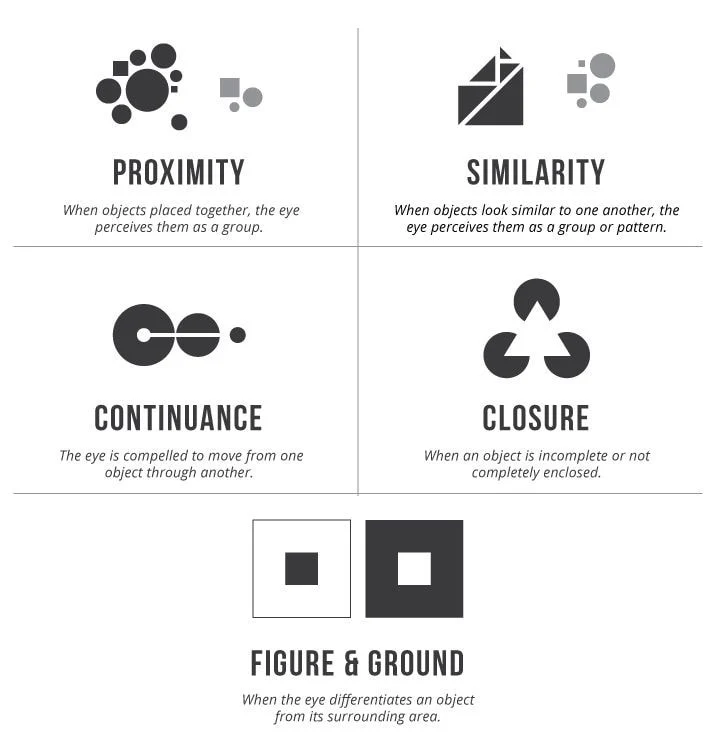
Closure
The gestalt principle that states that our brains tend to perceive incomplete forms as complete, filling in the gaps to create a unified, recognizable whole
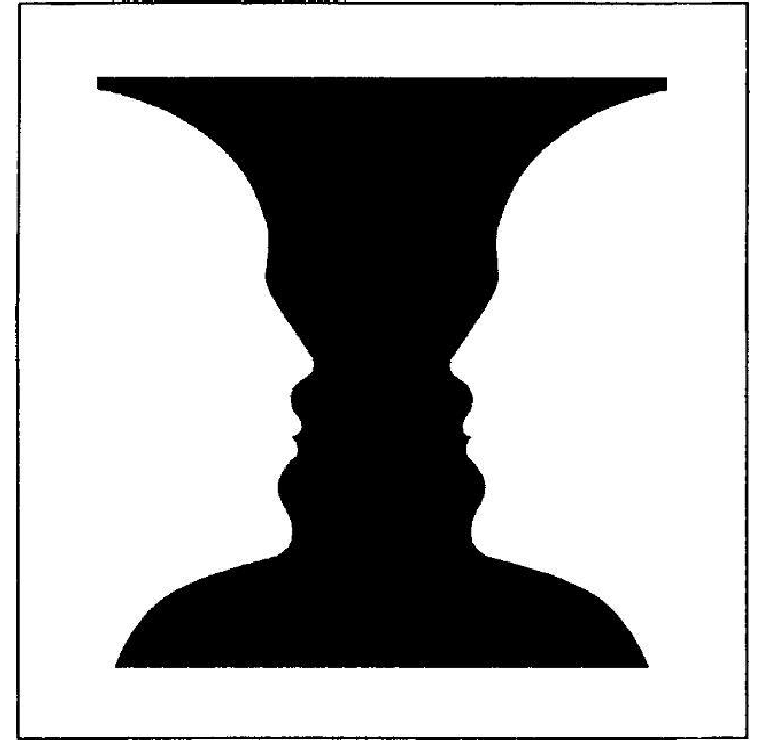
Figure-Ground Relationship
The tendency of the visual system to simplify a scene into the main object we are looking at (the figure) and everything else that forms the background (or ground)
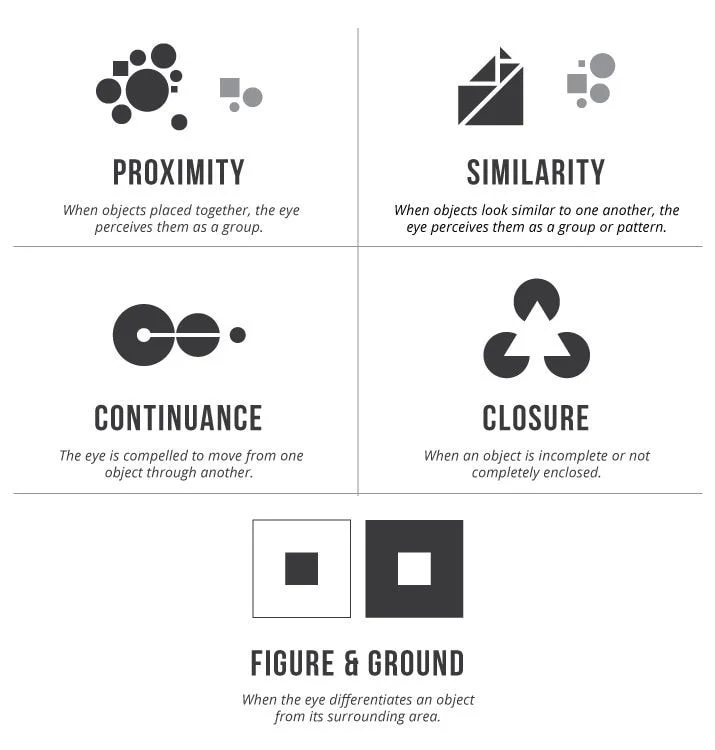
Proximity
The gestalt principle that states that objects that are close together are more likely to be perceived as belonging in the same group
Binocular Depth Cues
Depth cues that require both eyes to determine depth
Monocular Depth Cues
Depth cues that only require one eye to determine depth
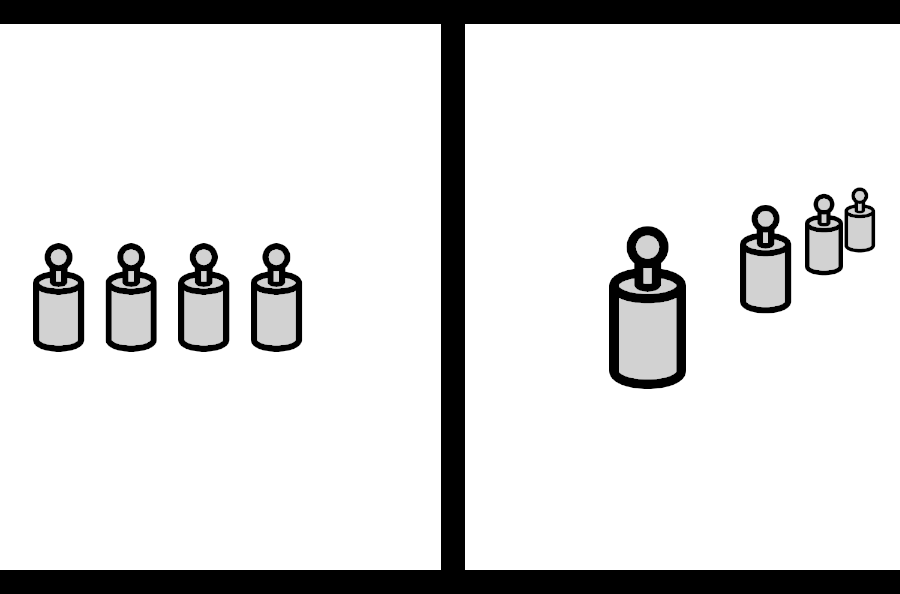
Relative Size
A monocular depth cue based on sizes of objects. If two objects are roughly equal in size, then the larger object is closer
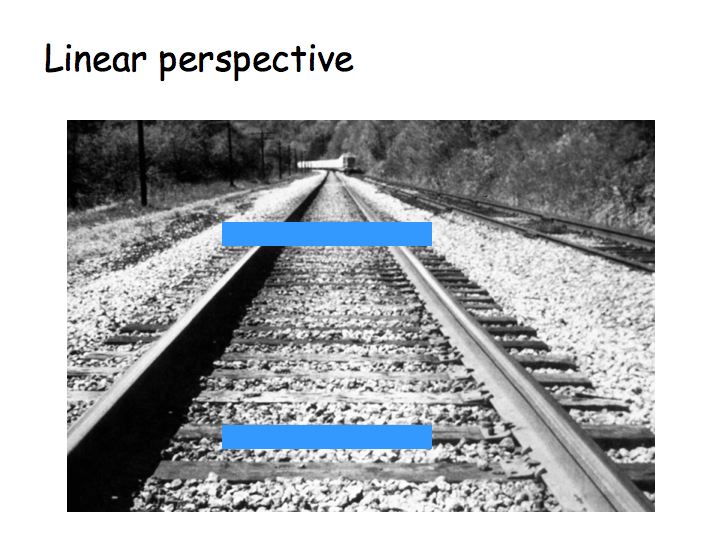
Linear Perspective
A monocular depth cue based on parallel lines converging. Closer away objects are near where the lines don’t converge, further are more near where they do

Interposition
A monocular cue based on the position on objects. Closer objects block further objects
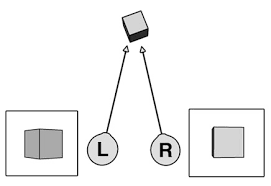
Retinal Disparity/Binocular Disparity
When each retina receives a slightly different angle of the same object to determine depth. Closer objects have a greater difference in what each eye sees, further the opposite (It is a binocular depth cue)
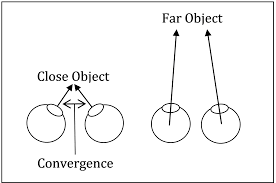
Convergence
A binocular depth cue based on how much the eyes rotate inward. The brain interprets the level of tension required for the eyes to keep focus on an object. Closer = turn inward more, more tension. Further = opposite
Perceptual Constancies
Help us maintain or see a stable perception in the face of continuously changing sensory input
Absolute Threshold
The smallest amount of stimulus we can detect (Technically 50% of the time)
E.g. In vision, it is the smallest amount of light we can detect
Subliminal Stimuli
Stimuli that are presented below the threshold of conscious awareness
Difference Threshold/Just-Noticeable Difference
The smallest amount of change needed in a stimulus before we can detect change
Weber’s Law
A psychological principle that states that the change needed for the difference threshold is proportional to the original intensity of the stimulus- the more intense the stimulus, the more it will need to change before we notice a difference
Signal Detection Theory
The detection of a stimulus depends on both the intensity of the stimulus and the physical/psychological state of the individual
E.g. Will the QB see the open receiver in the end zone despite the oncoming lineman?
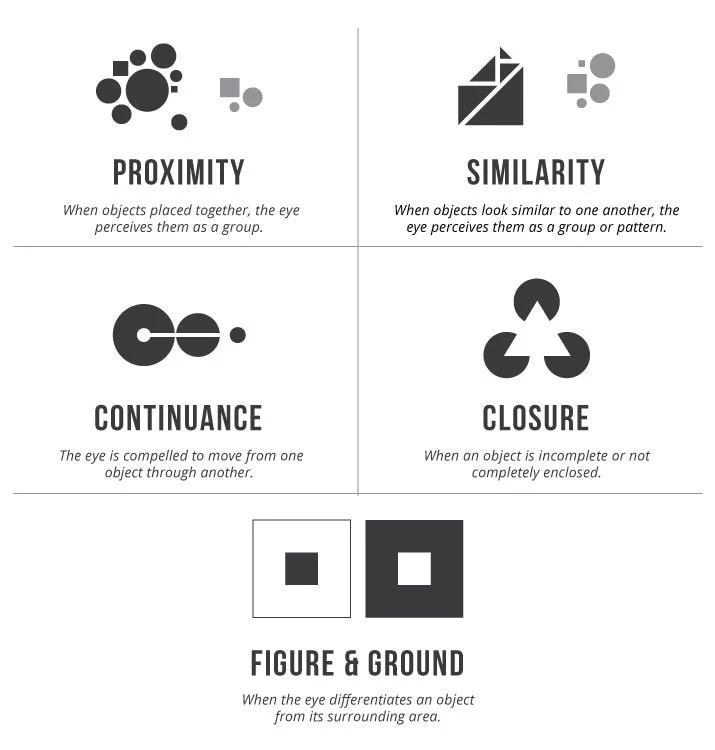
Similarity
The gestalt principle that states that objects that are similar in appearance are more likely to be perceived as belonging in the same group
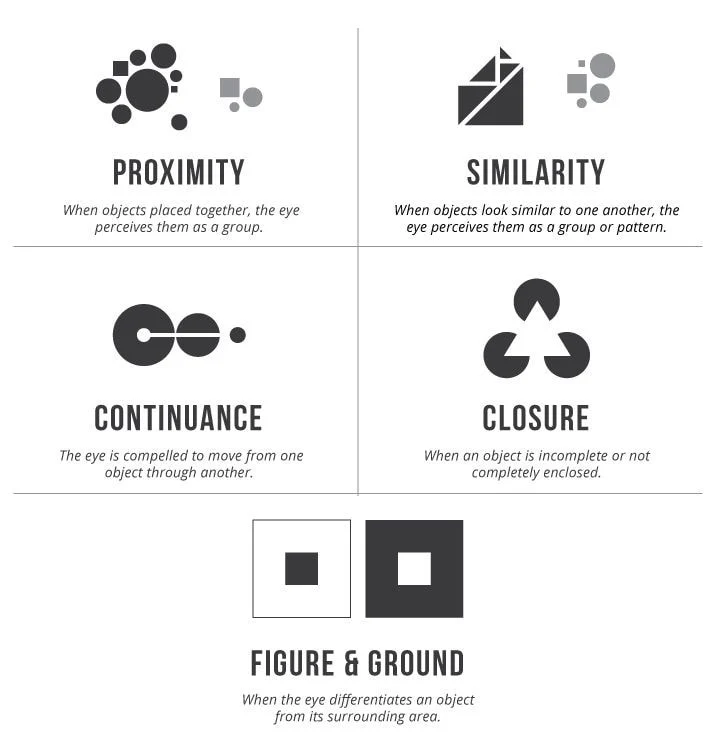
Continuity
The gestalt principle that states that objects that are arranged in a continuous line/curve are more likely to be perceived as belonging in the same group
Constancy
The tendency to perceive an object as remaining stable and unchanging despite changes in sensory input, such as alterations in its distance or in the light it reflects
Size Constancy
The perception that the size of an object remains constant even when viewed from different distances or angles
Shape Constancy
The tendency to perceive an object's shape as consistent, even when it is viewed from different angles or distances
Brightness Constancy
The tendency to perceive the brightness of an object as constant despite changes in the illumination conditions
Color Constancy
The perception that the color of an object remains the same under varying lighting conditions
Autokinetic Effect
If a spot of light is projected steadily onto the same place on a wall of an otherwise dark room and people are asked to stare at it, they will report seeing it move
Visual Cliff Experiment
An experiment created by Eleanor Gibson that is used to determine when infants can perceive depth. It involves placing an infant on one side of a glass-topped table, creating the impression of a cliff. The experiment found that children old enough to crawl will not crawl across the glass, I'm playing they have depth eprception
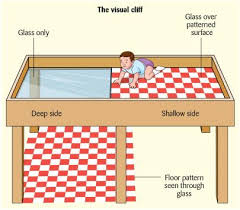

Texture Gradient
A monocular depth cue based on the detail of a surface. Closer objects have more detail, further ones have less

Relative Clarity
A monocular depth cue based on atmosphere pressure. Closer objects are more clear, further away appear more foggy
Prototypes
What we think is the most typical example of a particular concept
Algorithm
Step-by-step procedures that guarantee a solution (because all are tried). Often a time-consuming way to solve problems
E.g. you are trying to find chocolate chips in the grocery store, so you search every aisle until you find them
Heuristic
A thinking shortcut that is used to make a quick but not necessarily accurate judgment in situation
E.g. you are trying to find chocolate chips in a grocery store so go to the baking aisle
Availability Heuristic
Estimating the likelihood of events based on their availability in memory
E.g. you estimate your own neighborhood to be more violent than a neighboring one because you are more familiar with violence in your neighborhood, and examples of violence near you more quickly come to mind
Representativeness Heuristic
Estimating the likelihood of by comparing it to particular prototypes
E.g. a person may judge a young person more likely to commit suicide because of a prototype of the depressed adolescent, even when suicide rates are not really higher in younger populations
Belief Bias
When we make illogical conclusions to confirm our preexisting beliefs, leading us to support arguments that align with our views, regardless of the logic behind them
Belief Perseverance
Our tendency to maintain a belief even after the evidence we used to form our beliefs is contradicted
Gambler’s Fallacy
When we believe that a certain event or outcome is more or less likely to occur because of how often it has recently occurred
E.g. if a coin lands on heads repeatedly, a person might incorrectly believe that the next flip is more likely to be tails, even though each flip is independent
Sunk-Cost Fallacy
When we are unwilling to change a course of action because we spent a lot of effort and time trying to make that solution work, even when it becomes clear that the course of action is unlikely to solve a problem
Mental Set
Our tendency to approach a novel problem with the mindset of what has worked for us previously. It is a tendency to fall into established thought patterns
Functional Fixedness
The inability to see a new use for an object other than its intended purpose
Framing
The idea that the same information can be presented in different ways and the method of presentation can drastically change the way we view a problem or issue
E.g. A doctor saying “A majority of people survive this surgery” vs. “Almost half of the people who undergo this surgery die”. In both cases, he is telling the truth that 51% survive, but the way it is framed changes the perception
Creativity
The ability to produce ideas that are both novel and valuable
Convergent Thinking
Thinking pointed towards one singular solution
Divergent Thinking
Thinking that searches for multiple possible answers to a question
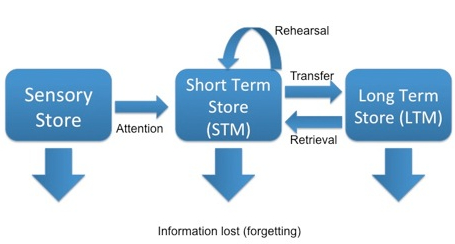
Multi-Store Model
The principal model of memory that states that there are three stages that information passes through before it is stored. First, external events are processed by our sensory memory. Then, information is encoded into our short-term (or working) memory. Finally, the information is encoded into long-term memory
Sensory Memory
The first stop for external events, it is a holding tank for incoming sensory information. All the information your senses are processing right now are held in sensory information for a very short period of time
Iconic Memory
A type of sensory memory that retains visual images for a brief moment (less than a second) after the stimulus has been removed
Echoic Memory
A type of sensory memory that retains auditory information for a few (3-4) seconds after the sound has stopped
Short-Term Memory
The capacity to hold a small amount of information in an active, readily available state for a short period of time. This part of your memory can hold roughly 7 pieces of information at once
Selective Attention
The ability to focus on one specific stimulus or sensory information while filtering out other, irrelevant stimuli
Inattentional Blindness
When we fail to perceive something that was in our visual field because we weren’t paying attention to it and were focused on something else
Working Memory
The idea that short-term memory isn’t just a space for briefly storing new information, it’s an active scratchpad where your brain makes sense of new input and links it to long-term memories
Central Executive
A system involved in working memory. It monitors incoming information and determines what other systems should be involved in processing information
Visuospatial Sketchpad
A system of working memory that holds and processes visual and spatial information, allowing us to visualize the world
Auditory/Phonological Loop
A system of working memory that processes and holds auditory information, such as sounds and spoken words.
Maintenance Rehearsal
A cognitive process used to maintain information in short-term memory by repetitively verbalizing or thinking about the information
Elaborative Rehearsal
A memory technique that involves linking new information to existing knowledge, thus promoting deeper understanding
Effortful Processing
Encoding information through conscious attention and effort
Long-Term Memory
A type of memory that stores information indefinitely and has a virtually unlimited capacity, allowing for the retrieval of extensive knowledge and experiences (However, just because it has unlimited capacity does not mean that information stored here is permanent, it can still fade)
Episodic Memory
A kind of long-term memory that involves remembering specific events, stored in a sequential series of events
E.g. remembering the last time you went on a date
Semantic Memory
A kind of long-term memory that involves general knowledge of the world, stored as facts, meanings, or categories rather than sequentially
E.g. knowing the difference between the terms “effect” and “affect”
Procedural Memory
A kind of long-term memory that involves memories of skills and how to perform them. There memories are sequential but might be too complicated to describe in words
E.g. knowing how to throw a curve ball
Explicit/Declarative Memories
Conscious memories of facts or events we actively try to remember and recall
E.g. when studying these flashcards, you are trying to form these kinds of memories about the terms so you can remember them on your AP test
Implicit/Nondeclarative Memories
Unintentional memories that we might not even realize we have
E.g. when cleaning your house, you may find you know how to scrub a floor because you’ve seen your parents do it, not because you ever tried to learn
Prospective Memory
Your memory for things you plan to do in the future
E.g. remembering to remember to plug your phone in before you go to sleep
Eidetic/Photographic Memoru
A rare and highly detailed form of visual memory that allows for the immediate and very accurate recall of images after a single exposure
Levels of Processing Model
A memory theory that explains why we remember what we do by examining how deeply the memory was processed or thought about. Rather than memories being short- or long-term, they are shallowly or deeply encoded
Shallow Processing
Processing that encodes memories at an elementary level- you will likely forget the information quickly
Deep Processing
Processing that encodes memories semantically, based on meanings. Because the processing is more meaningful, you are likely to be able to recall information later
Long-Term Potentiation
A persistent strengthening of synapses caused by repeated neuron firings. This is thought to be related to the connections we make in our long-term memory
Encoding
The process by which we put information into our memories
Primacy Effect
We are more likely to recall items presented at the beginning of a list
Recency Effect
We are more likely to recall items presented at the end of a list
Serial Position Effect/Serial Position Curve
The tendency to recall the first and last items in a list more easily than those in the middle
Method of Loci
A mnemonic device that involves using imagery to associate the things you want to remember with various physical spaces
E.g. if you need to remember what to pick up at the grocery store, you could imagine them in different places in your house
Spacing Effect
The phenomenon where we retain information better when we rehearse over time
Distributed Practice
Spreading out studying over a long period of time
Massed Practice
Studying large chunks of information over a short period of time
Chunking
Organizing items into familiar groups based on patterns for short term memory retention
E.g. acronyms
Mnemonic Devices
Memory aids that use associations, patterns, or imagery to enhance recall of information
E.g. songs, rhymes, acronyms, acrostics (Note there is lots of overlap with chunking)
Anterograde Amnesia
A condition where individuals are unable to form new memories after a specific (brain damaging) event, affecting recall of new information
Often caused by damage to the hippocampus
Retrograde Amnesia
A condition where individuals lose preexisting memories prior to a brain damaging event, which can affect personal history and learned facts
Retrieval
The process of getting information out of memory so we can use it
Recognition
A kind of retrieval that involves the process of matching a current event or fact with one already in memory
E.g. “Have I smelled this before?”
Recall
A kind of retrieval that involves retrieving Emory with an external cue
E.g. “What does my Aunt’s perfume smell like?”
Retrieval Cues
Stimuli that help people retrieve memories
Tip-Of-The-Tongue Phenomenon
A phenomenon that occurs when someone cannot recall a specific word or term, but feels certain that they know it
Semantic Network Theory
A memory theory that states that our brain might form new memories by connecting their meaning and context with meanings already in memory
Context-Dependent Memory
The phenomenon where recall of information is more successful when the retrieval context (environment, state) is similar to the encoding context (where the information was initially learned)